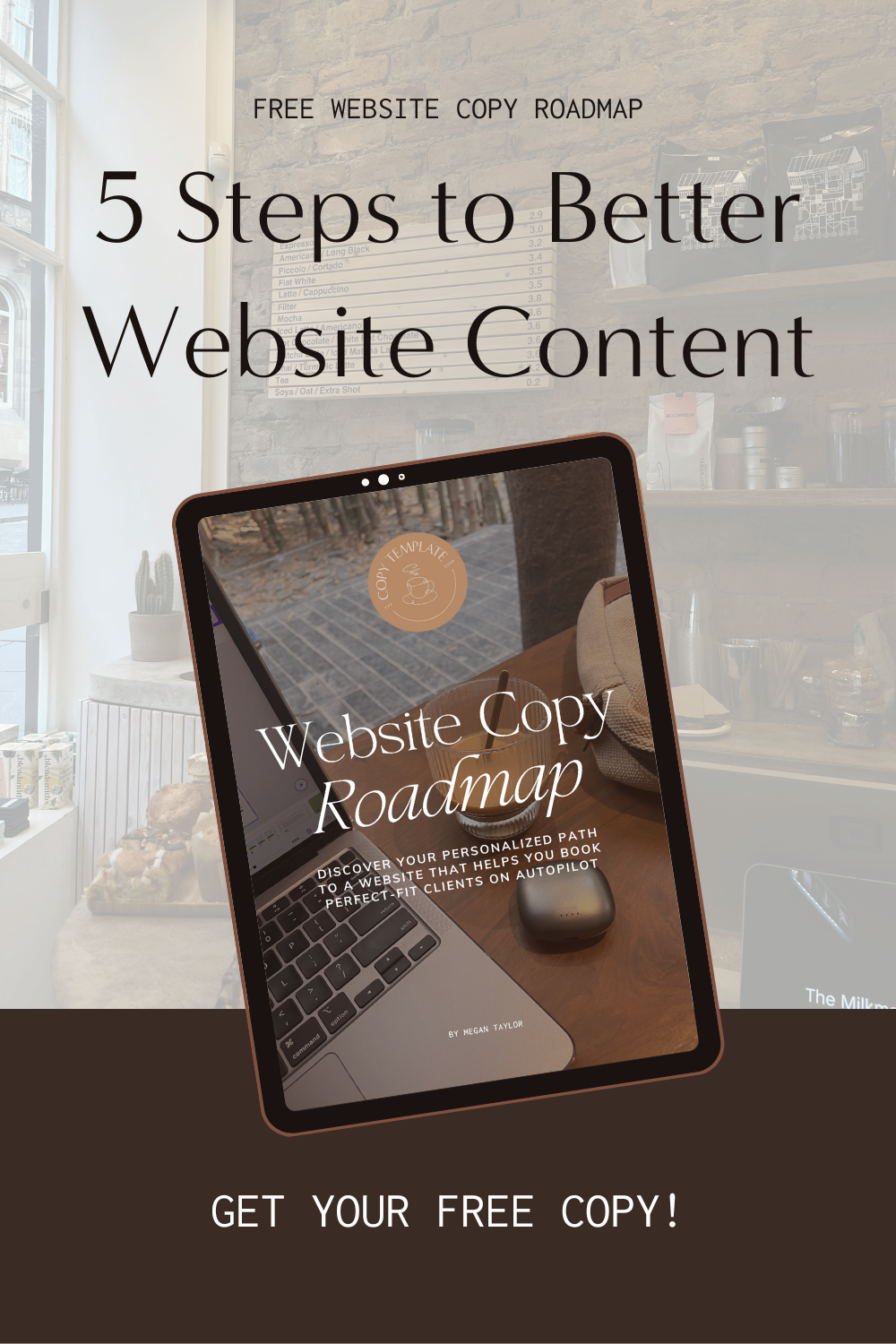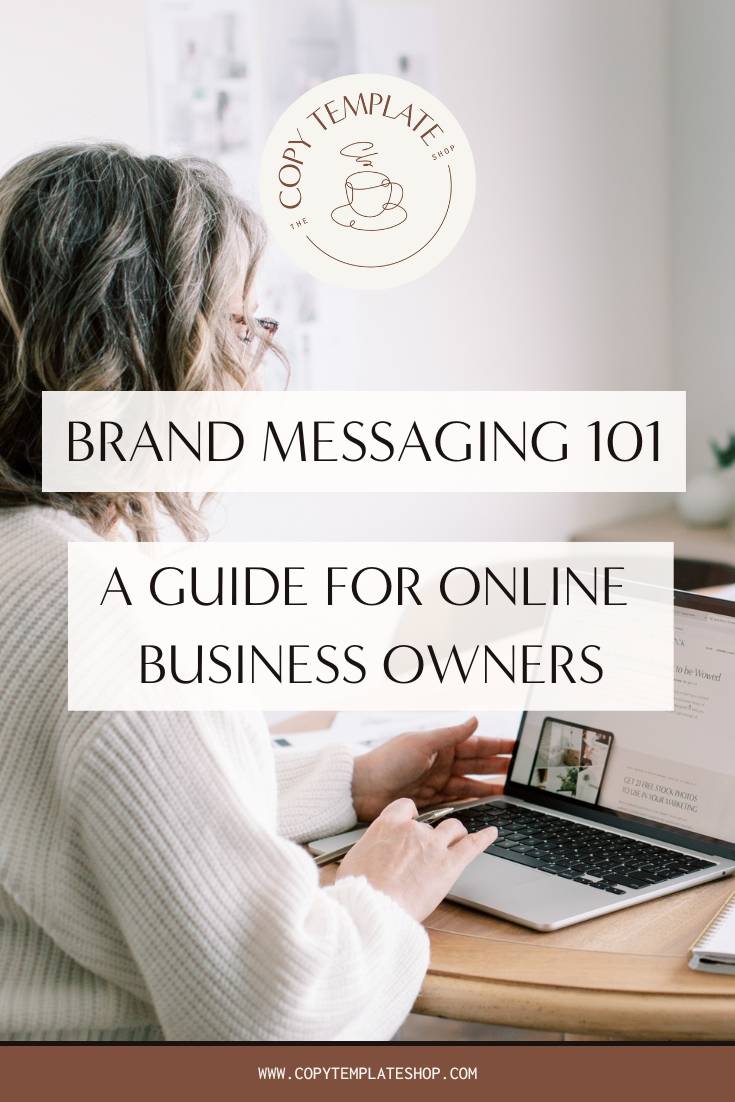No matter what you sell in your business, standing out online is more important than ever; and a lot of that comes down to your brand messaging strategy.
Brand messaging goes beyond pretty logos and catchy slogans to strategically outline how your brand is going to resonate with ideal clients. Crafting your brand messaging strategy not only helps you attract more buyers but also helps you forge authentic and lasting relationships with them.
In this post, we’ll explore what brand messaging is, why it’s important, and how you can start developing yours today. And, if you’re ready to get started, we’ll also introduce you to some helpful tools, including our Messaging Clarity Journal.
Prefer to listen than read? This episode of The Copy Dates Podcast will give you a quick overview of brand messaging and why it matters:
What is brand messaging?
A lot of people think that brand messaging is simply the way that you talk to your audience. And while that’s a piece of the puzzle, it’s not quite right.
Messaging is more than just the words you use or the energy you bring to a conversation with leads or buyers. It’s more than your elevator pitch or business slogan.
It’s also not the same as your brand voice, values, or niche — though they all play a role in your brand messaging strategy.
Brand messaging is the strategy that underlines the words you choose to communicate your unique value to the people you want to help.
Let’s break that definition down, piece by piece.
“The Strategy”
Coming up with your brand messaging isn’t something you just do on the fly or something that changes from day to day. When I say your brand messaging needs to be strategic, I mean it needs to:
- Be connected to your overarching business goals
- Specifically speak to the types of people you want to attract
- Help you stand out from the crowd
- Be seamlessly woven into your business’ marketing and sales
If you don’t take the time to do it right, it’s going to be infinitely harder for you to attract your perfect-fit buyers, establish the kind of business (and life) you want, and reach your goals.
“Underlines the word you choose”
If you’re no stranger to copywriting, you already know that the words you choose to market your business are crucial.
Your words need to accurately describe what your business does, who you help, what results you provide, and the value of those results. And (spoiler alert) that’s where brand messaging comes in.
Your brand messaging strategy helps you dictate that language, so you know exactly what words are going to resonate with the right people.
“Communicate your unique value”
Sure, niching down is important in online business. But, no matter how specific you get with your niche, there’s always going to be someone else doing what you do.
Your brand messaging strategy helps you go beyond your niche to clearly communicate why you are -someone worth buying from (or working with).
Think of Apple. Apple isn’t the only company out there making phones and computers. Yet we know it’s different — and that’s why the brand has such a chokehold on our modern society!
A lot of that comes down to Apple’s brand messaging. From its iconic “Think Different” campaign to its constant emphasis on innovation, minimalism, and quality, Apple’s messaging goes far beyond its niche. It’s not selling electronics: it’s selling a lifestyle.
You might not have even a fraction of Apple’s $1.8 billion marketing budget. But you do have the ability to craft a brand messaging strategy that communicates what makes you different from all the other options out there.
- If you’re a web designer, what makes your approach to web design so different from all the other designers I could find with a quick Google search?
- If you’re a business coach, what unique insight and experience do you bring to the table?
- If you sell vegan beauty and skincare products, what can you give your buyers that Sephora can’t?
“The people you want to help”
A brand messaging strategy can only really be effective if you know who you’re trying to reach. Only then can you clearly define things like the problem you’re solving and the transformation you’re delivering.
Do you have a clear picture in your head of who that dream buyer is? If you don’t, you’re going to have a really hard time coming up with the messaging and language that speaks to them.
When I say ‘speak to them’, I don’t just mean words that make them understand what you’re saying. I mean the words that make them think you might be a secret mind reader, looking into your crystal ball and seeing their day-to-day struggles and desires.
Brand messaging helps you ensure that the language you’re using attracts the right people to your business — and repels the wrong people. This way, you’re pre-qualifying clients who are ready to invest in your solutions.
Why does your business need a brand messaging strategy?
Without the right brand messaging, you’re never going to be able to connect with and convert your perfect-fit clients or customers. End of story.
Without a brand messaging strategy, there’s no way of making sure that you’re clearly communicating the right things to the right people. This means you might end up working with bad-fit clients, dealing with constant refund requests, or constant churn in your membership program.
Your messaging will impact all aspects of your business — from the type of offers you create, to the niche you focus on, to the way you attract clients, and so much more.
With an effective brand messaging strategy, you can benefit from:
- Not just more leads but better ones: clients who are a joy to work with and can afford your higher-ticket rates
- Opportunities for growth in your revenue, visibility, and impact
- Purposeful work: the kind of work that got you buzzing and excited to start your business in the first place
- Partnerships with the right kind of people: people with the same values and ideas as you who also want to serve your target audience
How to create your brand messaging strategy
We provide a clear, step-by-step path for developing your brand messaging strategy in The Messaging Clarity Journal, with 60+ comprehensive prompts. But, here are the most basic steps to follow if you’re just getting started.
1. Take a look at your existing messaging
Start by looking at the language you’re currently using in your marketing, including on your website and on your social media. Is it aligned with your current business goals and values? Does it resonate with your ideal clients?
Similarly, how relevant is your current messaging? Is there anything that feels outdated or misaligned with your current goals and who you’re trying to reach?
2. What is the vision for your business?
Think about where you see your business in the next year. What new offers are you hoping to launch? Are there any new audiences you’d like to reach? What are your sales goals?
What about the next 5-10 years? Do you see yourself making any big shifts in who you work with, how you help them, and how you’d like to be perceived in your industry?
While some of these plans might feel far away right now, it’s important to take them into consideration as you build out your brand messaging strategy. How are you going to make sure that the language you’re using supports that bigger vision?
3. Who are your inspirations, and why?
Take a look at other businesses both inside and outside of your industry and analyze their messaging. What do you like, and maybe want to replicate (in your own way)? What do you dislike and want to do differently?
While we never want to copy others, understanding what draws us to brands we admire can help us generate ideas for our own brand messaging strategy.
4. What is your brand’s voice?
If you had to give your business a personality, what would it be? How can you make sure that’s helping you attract good-fit clients, and repelling bad-fit clients? And, most importantly, is this consistent across all of your marketing channels?
Your brand voice can also include things like your opinions or stances on popular topics. What “hot takes” can you share that make you stand out from the competition?
5. Who is your dream client?
Remember: the foundation of our brand messaging strategy involves getting clear on who we’re actually trying to reach.
Consider things like the problems your ideal client is facing and what solutions they’re already looking for. If you can identify the outcomes these clients want, you can better direct your offers and services to them.
6. What are your brand stories?
Stories help us humanize our brand, and showcase the individuality behind our business. Consider any stories you can share to help you engage your readers and build connection with them, such as pivotal business moments, client success stories, or insights from your everyday life.
Messaging is not a “one and done” kind of thing
Your brand messaging must be directly tied to your business goals. So, as your goals change, your messaging needs to change right along with it.
When developing your brand messaging strategy, think about what you are trying to achieve and who you are trying to attract right now.
But, be sure to take your messaging along for the ride as things evolve and change. This is why I highly recommend having a guide like The Messaging Clarity Journal and revisiting it every 6-12 months.
What’s your brand messaging strategy?
Whether you’re a business newbie or have been in the entrepreneurship game for years, it doesn’t matter: everyone needs a brand messaging strategy.
While your visual brand may be the pretty face you put out into the world, your brand messaging is the personality underneath — and can arguably be even more important when attracting and converting the right buyers for your offers.
If you’re ready to create or revisit your brand messaging, be sure to get your hands on our Messaging Clarity Journal. This much-loved resource will help you uncover the words that will support the vision you have for your business. You’ll be left with a clear messaging strategy that helps you create more connection and memorability with your copy.




